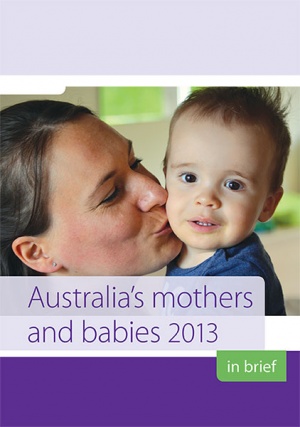Australia’s mothers and babies 2013
| Embryology - 28 Apr 2024 |
|---|
| Google Translate - select your language from the list shown below (this will open a new external page) |
|
العربية | català | 中文 | 中國傳統的 | français | Deutsche | עִברִית | हिंदी | bahasa Indonesia | italiano | 日本語 | 한국어 | မြန်မာ | Pilipino | Polskie | português | ਪੰਜਾਬੀ ਦੇ | Română | русский | Español | Swahili | Svensk | ไทย | Türkçe | اردو | ייִדיש | Tiếng Việt These external translations are automated and may not be accurate. (More? About Translations) |
Introduction
This data summarised below is provided to help you as a clinician or researcher understand the current trends in reproductive medicine within Australia.
The information is based upon data from the publication "Australia's mothers and babies 2013"[1] and is provided for educational purposes only. The original full publication is available online from Cat. no. PER 72.
| Australia’s mothers and babies: 2017 | 2016 | 2015 | 2014 | 2013 | 2012 | 2011 | 2010 | 2009 | 2008 | 2007 | National Perinatal Statistics Unit | AIHW | Australian Statistics | birth |
Australia’s mothers and babies 2013
Australia’s mothers and babies 2013
AIHW 2015. Australia's mothers and babies 2013—in brief. Perinatal statistics series no. 31. Cat. no. PER 72. Canberra: AIHW. PDF
Mothers at a glance
Women are giving birth later in life
- The average age of all women who gave birth was 30.1 years in 2013, compared with 29.5 in 2003.
- The average age has also increased for Aboriginal and Torres Strait Islander mothers, from 24.7 in 2003 to 25.3 in 2013.
- The proportion of mothers aged 35 and over has increased from 19% in 2003 to 22% in 2013, while the proportion of mothers aged less than 24 has decreased from 19% to 17%.
- The average age of first time mothers also increased, from 27.8 years in 2003 to 28.6 in 2013.
- Most mothers live in Major cities and were born in Australia
- Most mothers lived in Major cities (71%) and most were born in Australia (69%)—similar to the proportions of all women of reproductive age in the population.
- 1 in 25 mothers are Aboriginal and/or Torres Strait Islander
- Around 4.1% of all women who gave birth in 2013 were Indigenous, slightly higher than the proportion of Indigenous women of reproductive age in the population (3.3%).
- Indigenous mothers were on average younger than non-Indigenous mothers (25.3 years compared with 30.3).
Babies at a glance
More babies are being born
- There were 309,489 babies born in 2013—an increase of 20% from 256,925 in 2003.
- 307,277 were live births and 2,191 were stillbirths (less than 1%).
- The stillbirth rate of 7 deaths per 1,000 births has not changed substantially since 2003.
- Baby boys slightly outnumber baby girls
- Slightly more babies were male (51%) than female (49%).
- The sex ratio, defined as the number of male live born babies per 100 female live born babies, was 106.0.
- 1 in 20 babies are Aboriginal and/or Torres Straight Islander
- Around 1 in 20 babies (5.2% or 16,149) were Indigenous in 2013 (based on Indigenous status of the baby).
- 3 in 4 babies are born to mothers living in New South Wales, Victoria or Queensland
The proportion of babies born in each state and territory closely reflects the distribution of the total population in 2013 (based on the mother’s state/territory of usual residence).
References
- ↑ AIHW 2015. Australia's mothers and babies 2013—in brief. Perinatal statistics series no. 31. Cat. no. PER 72. Canberra: AIHW. PDF Viewed 13 December 2015. http://www.aihw.gov.au/publication-detail/?id=60129553770
Glossary Links
- Glossary: A | B | C | D | E | F | G | H | I | J | K | L | M | N | O | P | Q | R | S | T | U | V | W | X | Y | Z | Numbers | Symbols | Term Link
Cite this page: Hill, M.A. (2024, April 28) Embryology Australia’s mothers and babies 2013. Retrieved from https://embryology.med.unsw.edu.au/embryology/index.php/Australia%E2%80%99s_mothers_and_babies_2013
- © Dr Mark Hill 2024, UNSW Embryology ISBN: 978 0 7334 2609 4 - UNSW CRICOS Provider Code No. 00098G
